Ever looked at a bunch of spotty, soft bananas on your kitchen counter and thought, “Are these still good?” You’re not alone. Most of us have tossed overripe bananas without realizing they’re actually at their baking peak. Far from being trash, those speckled peels signal sweetness, moisture, and flavor that can transform your baked goods from ordinary to extraordinary. In fact, many professional bakers and home cooks alike consider overripe bananas a secret weapon in the kitchen.
In this article, we’ll explore the surprisingly versatile world of overripe bananas in baking. You’ll discover why they’re not just edible—but ideal—for recipes ranging from classic banana bread to inventive desserts like banana pancakes, muffins, and even savory-sweet banana-based sauces.
We’ll also cover practical tips for storing, freezing, and maximizing their potential, plus creative twists that go beyond the usual loaf. Whether you’re trying to reduce food waste, save money, or simply bake something delicious, this guide will show you how to turn those “too ripe” bananas into culinary gold.
Let’s peel back the layers (pun intended!) and uncover the magic hidden in those brown-speckled fruits.
Why Overripe Bananas Are a Baker’s Best Friend
You might wonder: what makes an overripe banana so special for baking? The answer lies in chemistry—and flavor. As bananas ripen, their starches convert into natural sugars. A green banana is full of resistant starch, which is great for digestion but not so much for sweetness. By the time a banana turns yellow with brown spots, it’s packed with fructose, glucose, and sucrose—making it significantly sweeter and more aromatic.
This natural sweetness means you can often reduce or even eliminate added sugar in your recipes. Plus, overripe bananas are softer and easier to mash, blending seamlessly into batters without lumps. Their moisture content also helps keep baked goods tender and moist—no dry banana bread here!
Consider this: a single overripe banana contains about 100–120 calories, mostly from natural sugars, along with potassium, vitamin B6, and fiber. When used in baking, these nutrients don’t just vanish—they enhance the nutritional profile of your treats. And because they’re so flavorful, you don’t need artificial extracts or excessive butter to achieve richness.
In short, overripe bananas aren’t just “okay to use”—they’re the ideal ingredient for moist, naturally sweet, and deeply flavorful baked goods. So next time you see those brown spots, smile: your dessert just got a major upgrade.
Classic Comfort: Reinventing Banana Bread and Muffins
Let’s start with the most beloved use for overripe bananas: banana bread. But don’t stop at the standard recipe—this is your chance to get creative. Traditional banana bread relies on 2–3 mashed overripe bananas as its base, but from there, the possibilities are endless.
Want a healthier twist? Swap half the all-purpose flour for whole wheat or oat flour. Add a handful of chopped walnuts or pecans for crunch, or fold in dark chocolate chips for a decadent touch. Feeling adventurous? Try adding a teaspoon of cinnamon, a pinch of nutmeg, or even a swirl of peanut butter through the batter before baking.
Muffins offer even more flexibility. Because they bake faster and in individual portions, they’re perfect for experimenting. Try banana-oat muffins with a sprinkle of turbinado sugar on top for a bakery-style finish. Or go savory-sweet with banana and cheddar muffins—yes, it works! The mild tang of sharp cheddar balances the banana’s sweetness in a surprisingly harmonious way.
Pro tip: Freeze overripe bananas (peeled and placed in a zip-top bag) for future baking. When you’re ready to bake, just thaw and mash—they’ll be even softer and sweeter.
These classics aren’t just nostalgic—they’re blank canvases. With a few tweaks, your banana bread or muffins can become a signature dish that friends and family beg you to make again and again.
Beyond the Loaf: Unexpected Baking Ideas with Overripe Bananas
Now that we’ve covered the classics, let’s think outside the (bread) box. Overripe bananas can elevate a wide range of baked goods you might not expect.
Take pancakes, for example. Blend one mashed banana with eggs, a splash of milk, and a bit of flour or oats for fluffy, naturally sweet pancakes—no syrup needed. Kids especially love them, and they make a nutrient-rich breakfast that feels like a treat.
Or consider banana brownies. Replace part of the oil or butter in your favorite brownie recipe with mashed banana. The result? Fudgy, moist brownies with a subtle fruity depth that cuts through the richness. Add a swirl of caramel or a sprinkle of sea salt on top for gourmet flair.
Even cookies benefit from banana magic. Try banana-oatmeal cookies with raisins or dried cranberries—they hold together beautifully thanks to the banana’s binding properties, and they’re naturally lower in fat. For a tropical twist, mix in shredded coconut and macadamia nuts.
And don’t overlook banana cake. Lighter than banana bread but just as flavorful, it pairs wonderfully with cream cheese frosting or a simple dusting of powdered sugar. Serve it at birthdays or brunches for a crowd-pleasing dessert that feels both familiar and fresh.
The key takeaway? Overripe bananas aren’t limited to one recipe—they’re a multi-purpose baking ingredient that adds moisture, sweetness, and structure wherever they go.
Smart Storage and Prep Tips to Maximize Flavor and Reduce Waste
Even the best baking ideas fall flat if your bananas aren’t stored properly. Fortunately, a few simple habits can ensure you always have ripe bananas ready when inspiration strikes—and keep food waste to a minimum.
First, don’t throw away bananas just because they’re overripe. If you’re not ready to bake, peel them and freeze them in a labeled freezer bag. They’ll keep for up to 6 months and thaw quickly at room temperature or in the microwave. Bonus: frozen bananas are perfect for smoothies too!
If you want to speed up ripening, place green bananas in a paper bag with an apple or tomato. These fruits release ethylene gas, which accelerates ripening. Conversely, to slow down the process, store bananas away from other fruits and consider wrapping the stems in plastic wrap to reduce ethylene exposure.
When prepping bananas for baking, mash them thoroughly—a fork works fine, but a potato masher or immersion blender gives an ultra-smooth consistency. For extra flavor, caramelize them lightly in a skillet with a touch of butter before adding to your batter. This deepens their sweetness and adds a subtle toffee note.
Also, measure accurately. A medium overripe banana yields about ½ cup mashed. If your recipe calls for two bananas, aim for 1 cup total. Too much banana can make baked goods dense; too little, and you lose moisture.
By mastering these simple techniques, you’ll not only reduce kitchen waste but also unlock consistent, delicious results every time you bake.
Sustainability and Savings: The Bigger Picture of Using Overripe Bananas
Using overripe bananas isn’t just about great taste—it’s also a small but meaningful act of sustainability. According to the United Nations Food and Agriculture Organization, roughly one-third of all food produced globally is wasted. In households, fruits like bananas are among the most commonly discarded items, often because people don’t know how to use them past their “perfect” stage.
By repurposing overripe bananas in baking, you’re doing your part to combat this waste. Plus, you’re saving money. Think about it: instead of buying applesauce, oil, or extra sugar to add moisture and sweetness to your recipes, you’re using an ingredient you already have—free, nutritious, and zero-waste.
This mindset extends beyond bananas. Once you start seeing “imperfect” produce as an opportunity rather than a liability, you’ll find creative uses for soft tomatoes (sauces!), wilted herbs (pesto!), and stale bread (bread pudding!). It’s a shift that benefits your wallet, your kitchen, and the planet.
Moreover, baking with overripe bananas teaches mindfulness. It encourages you to plan ahead, store food wisely, and appreciate the full lifecycle of your ingredients. In a world of convenience and excess, that’s a valuable lesson—and a delicious one at that.
So the next time you see those brown spots, remember: you’re not just baking a treat. You’re practicing sustainability, one banana at a time.
Conclusion
Overripe bananas are far from past their prime—they’re at the height of their baking potential. From the comforting familiarity of banana bread to the surprising versatility of banana pancakes, brownies, and cakes, these humble fruits can transform your baked goods with natural sweetness, moisture, and flavor. By storing them properly, freezing extras, and experimenting with creative recipes, you’ll not only reduce food waste but also discover new favorite treats.
We’ve explored why overripe bananas work so well in baking, revisited classic recipes with modern twists, ventured into unexpected desserts, shared practical storage tips, and highlighted the environmental and economic benefits of using every last banana. The message is clear: those speckled peels are a gift, not a problem.
Now it’s your turn. Next time your bananas ripen faster than expected, don’t toss them—grab your mixing bowl instead. Try a new recipe, tweak an old favorite, or simply enjoy the satisfaction of turning “waste” into wonder.
What’s your go-to recipe for overripe bananas? Have you ever tried banana in a savory bake or frozen them for smoothies? Share your ideas in the comments below—we’d love to hear how you’re making the most of nature’s sweetest kitchen helper! And if you found this guide helpful, don’t forget to share it with a fellow baker or food lover who could use a little banana inspiration. Happy baking!

Thayná Alves is an influential digital content creator who has carved out a significant space in the realms of technology, finance, and entrepreneurship. Through her blog, Newbacker.com , she stands out as an authentic and accessible voice for individuals seeking practical information about investments, innovation, and emerging trends in the financial market.
